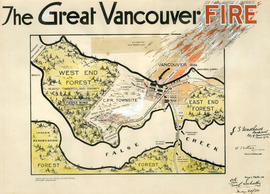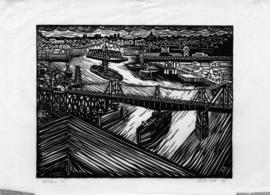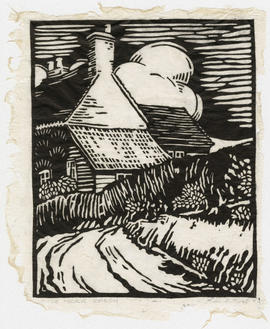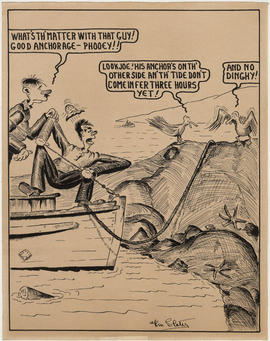Title and statement of responsibility area
Title proper
City of Vancouver Archives documentary art collection
General material designation
- Graphic material
Parallel title
Other title information
Title statements of responsibility
Title notes
Level of description
Fonds
Reference code
Edition area
Edition statement
Edition statement of responsibility
Class of material specific details area
Statement of scale (cartographic)
Statement of projection (cartographic)
Statement of coordinates (cartographic)
Statement of scale (architectural)
Issuing jurisdiction and denomination (philatelic)
Dates of creation area
Date(s)
Physical description area
Physical description
ca. 1,500 graphic materials
Publisher's series area
Title proper of publisher's series
Parallel titles of publisher's series
Other title information of publisher's series
Statement of responsibility relating to publisher's series
Numbering within publisher's series
Note on publisher's series
Archival description area
Name of creator
Administrative history
On May 16, 1932 City Council approved the recommendation of the Special Committee re Archives that an archivist be appointed to serve under the jurisdiction of the Library Board, then on June 12, 1933 absolved the Library Board from responsibility and appointed a City Archivist, J. S. Matthews. Established in 1933, the Archives became a City department in 1957, then subsequently a division of the City Clerk's Department in 1971. Archives and records management functions have developed as outlined below.
(1) Access and reference. Description and access tools have been prepared from the beginning and reference services on matters relating to Vancouver history and the records held have been provided from the beginning. From the 1930s indexes to photographs and news clippings had been prepared. From 1971 finding aids were greatly increased to include inventories of public and private records, card indexes providing varieties of access points, map collection description, and library catalogues. The Archives began automating finding aids and further standardizing description in 1992. Reference service was initially provided by the City Archivist and assistants, and by the reorganization and expansion of the early 1970s, by the staff of several archivists.
(2) Acquisition. Since 1971 the Archives has been identifying and acquiring both City and private sector archival records relating to the history of Vancouver. Previous to 1971 the Office of the City Clerk was the primary records keeper of City records, and from 1933 the City Archives had collected private records perceived of historical value (that collection had been started by the Archivist in about 1920).
(3) Preservation. Storage and preservation activities have been carried out since about 1920. Conservation expertise increased from 1976 when a conservator was first hired.
(4) Records management. Records analysis and retention scheduling began in 1973 when the City's first Records Manager was hired. The position title was changed to Records Administrator in 1995 as part of the City's position title standardization activity. Electronic records management is administered by Information Technology; the process was monitored by an Electronic Records Committee, of which the Records Manager has been a member.
(5) Records storage. The Records unit has been operating a Records Centre which stores and retrieves the records of all offices until disposition by disposal or transfer to the Archives, according to the records schedules.
Previous to the appointment of the first City Archivist, J. S. Matthews, in June 1933, Matthews had collected private papers, conversations with pioneers, photographs, maps and news clippings from the early 1920s which all became the initial holdings of the City Archives. The Archives became the official custodian of the City of Vancouver government records in 1971; previous to that they were kept by originating offices or another unit requiring their use, taken by officials when they retired, or, if deemed Council related or of legal importance, were kept by the Office of the City Clerk.
Initially the City Archivist reported to the Library Board (May-June 1933), then to the Special Committee re Archives/Archives Committee (June 12, 1933 - 1971), and since 1971, to the City Clerk.
As of 1971 the Archives has been divided into two units: Archives and Records.
The Archives has been known by the following names: City Archives, 1933-1957; Archives Department, 1957-1971; and more recently, referred to as City of Vancouver Archives, 1971- , while formally known as the Archives and Records Division, 1971- .
The following individuals have served as City Archivist:
- 1933-1970 J. S. Matthews
- 1971-1972 Robert D. Watt
- 1973-1975 R. Lynn Ogden
- 1975-2003 Susan M. Baptie
- 2004-2007 Reuben Ware
- 2007-2013 Leslie Mobbs
-
2013- Heather Gordon
For a more detailed administrative history, which includes reference to holdings ownership disputes of the 1930s and 1940s, please consult the City of Vancouver Archives fonds inventory in the Reading Room.
Custodial history
Scope and content
The City of Vancouver Archives documentary art collection consists of visual art works relating to the social, political, cultural and artistic history of Vancouver. Items in the collection include original works of art (acrylic, oil, and watercolor paintings; drawings; cartoons; and illuminations), original prints, and sculptures.
The works in the City of Vancouver Archives documentary art collection are differentiated from other categories of art by their emphasis on factual, objective representation rather than conceptual or interpretive representation. Each item in the collection represents a notable person, site, or event.










![Lonely trail, Chekamus [Cheakamus]](/uploads/r/null/a/8/e/a8ec72ecb680876796ba23afab9b04dc2f1577cf3e18c3f18d2476dd05bd03c3/e5cafb52-1d49-4bdf-a075-87bced706210-78-59_142.jpg)



